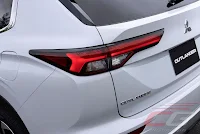Mitsubishi Motors has finally unveiled its all-new Outlander Plug-In Hybrid Vehicle (PHEV) which goes on same in Japan, Oceania, and North America in 2022.
The all-new 2022 Outlander PHEV model is Mitsubishi’s flagship model which brings together its expertise in electrification and all-wheel control technologies, while also incorporating a newly-developed platform and an array of advanced technologies.
Based on the product concept of “I-Fu-Do-Do” or authentic and majestic in Japanese, it adds a new dimension to the powerful ride, roomy interior spaces and wide-ranging functionalities expected of an SUV, along with the smooth yet powerful acceleration, and the safe, secure and comfortable ride unique to an electric vehicle (EV) in any driving conditions.
To further enhance its appeal as an EV, Mitsubishi has completely revamped the Outlander’s PHEV components, extending its EV driving range. With an increase of around 40 percent in the output of the front and rear motors and drive battery, the new model can keep driving in EV mode, and avoid starting the engine as much as possible even when pressing hard on the accelerator. Switching to a large capacity drive battery with total capacity of 20 kWh raises the all-electric range to 87 kilometers.
The 4B12 2.4-liter engine makes 98 horsepower and 195 Nm of torque, while the electric motors make 115 horsepower (85 kw) and 255 Nm of torque at the front and 136 horsepower (100 kw) and 195 Nm of torque at the back.
Furthermore, combining the rear motor with the control unit also secured enough floor space to install third row of seats, enabling a seven-passenger seating layout. Installing the control unit on the outside of the passenger compartment has also helped to shut out high-frequency noise for better quietness.
Another new innovation is a one-pedal operation mode which makes it possible to both accelerate and decelerate just by controlling the accelerator pedal. The accelerator pedal alone can exert proper braking force with no need to switch to the brake pedal when decelerating, so drivers can concentrate on steering and have more peace of mind in slippery surfaces such as snowy roads, as well as reducing the fatigue caused by switching pedals.
Mitsubishi’s trademark S-AWC (Super-All Wheel Control) now has a new brake AYC (Active Yaw Control) function for the rear wheels. This allows the system to distribute the driving force to the front and rear wheels optimally according to road and driving conditions, while torque vectoring by controlling the brakes on the left and right wheels is also possible for the front and rear wheels. This makes it possible to extract the maximum performance from all four tires.
Seven drive modes can be selected depending on road surface conditions and driving style—Normal, Tarmac, Gravel, Snow, Mud, Power, and Eco.
The newly developed platform and highly rigid structure also uses hot stamped ultra-high tensile steel. These along with Mitsubishi’s suite of driver assist features including Adaptive Cruise Control (ACC) and Lane Keep Assist (LKA) promises to make it one of the safest compact SUVs around.
Inside, award-winning interior design features a horizontally-sculpted instrument panel. The center console is designed to project a broad high-class presence. Finely textured soft padding that is pleasing to the touch can be found all over the interior, with stitching added for a high-quality feel. Based on the Mitsubishi Touch approach, the monitors and gauges are designed to be reassuringly easy to see, while the selectors, dials and switches are designed to provide a confident grip and operation, resulting in a quality feel that appeals to the senses.
So far, Mitsubishi hasn’t confirmed the all-new Outlander PHEV for ASEAN markets, but given that the Philippines got the current-generation model, it’s just going to be a matter of when, not if, the country will get the next-generation compact SUV.





















Torque vectoring by braking is pretty much what every AWD crossover/sedan does. AYC isn't anything special here, and the AWD should be far less complicated since the front and rear are powered independently by different motors, meaning no need for any trick center differentials. When it comes to AWD systems with center diffs, Subaru kept on improving while Mitsubishi pretty much stayed the same. I'm impressed they managed to fit all that hardware + extra 2 seats on a compact crossover body, but I doubt the overall range and gas consumption will be good with 7 people on board.
ReplyDeleteExcellent PHEV, however, the current model is outdated and not similar to what other countries are offering.
ReplyDeleteNew models in the Philippines, as a matter of policy, are always outdated by about 4 years.
ReplyDelete